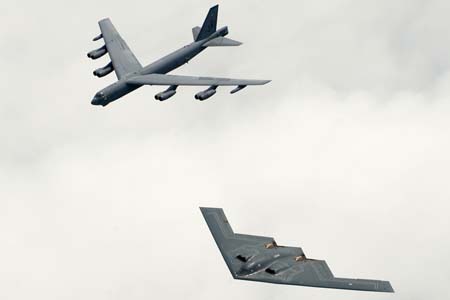Without fanfar e, the Air Force has begun placing its B-2A and B-52H bomber wings in rotations designed to stress training and preparation to execute their nuclear mission, the Daily Report has learned. In an interview last week, Col. James Dunn, Air Combat Command’s nuclear enterprise director, said the Global Deterrence Force construct went into effect on Oct. 1. The GDF, he said, will provide a focused training venue “to increase the nuclear experience and the readiness of our force.” At the same time, the GDF is not meant to undermine the conventional mission that the dual-role bombers have, he noted. Under the construct, the Air Force’s two B-52 wings, the 2nd Bomb Wing at Barksdale AFB, La., and the 5th BW at Minot AFB, N.D., will rotate into the GDF for alternating one-year intervals. The B-52 wing outside of the GDF will continue to be a part of Air and Space Expeditionary Force deployments to support conventional operations in places like Southwest Asia, or will deploy to Guam, where the US maintains a continual bomber presence by rotating assets about every four months. The 2nd BW is now in the GDF, but its initial rotation runs only through March 2009. When the 5th BW takes over next April, the full one-year stints will commence. The Air Force’s sole B-2A wing, the 509th BW at Whiteman AFB, Mo., is part of the GDF at all times, but some of its elements will continue to support conventional AEF deployments or rotate to Guam. To support the GDF, the Air Force intends to create a fourth B-52 operational squadron, with proposed basing at Minot. The GDF is one of numerous initiatives that the Air Force is undertaking to improve its nuclear stewardship.
e, the Air Force has begun placing its B-2A and B-52H bomber wings in rotations designed to stress training and preparation to execute their nuclear mission, the Daily Report has learned. In an interview last week, Col. James Dunn, Air Combat Command’s nuclear enterprise director, said the Global Deterrence Force construct went into effect on Oct. 1. The GDF, he said, will provide a focused training venue “to increase the nuclear experience and the readiness of our force.” At the same time, the GDF is not meant to undermine the conventional mission that the dual-role bombers have, he noted. Under the construct, the Air Force’s two B-52 wings, the 2nd Bomb Wing at Barksdale AFB, La., and the 5th BW at Minot AFB, N.D., will rotate into the GDF for alternating one-year intervals. The B-52 wing outside of the GDF will continue to be a part of Air and Space Expeditionary Force deployments to support conventional operations in places like Southwest Asia, or will deploy to Guam, where the US maintains a continual bomber presence by rotating assets about every four months. The 2nd BW is now in the GDF, but its initial rotation runs only through March 2009. When the 5th BW takes over next April, the full one-year stints will commence. The Air Force’s sole B-2A wing, the 509th BW at Whiteman AFB, Mo., is part of the GDF at all times, but some of its elements will continue to support conventional AEF deployments or rotate to Guam. To support the GDF, the Air Force intends to create a fourth B-52 operational squadron, with proposed basing at Minot. The GDF is one of numerous initiatives that the Air Force is undertaking to improve its nuclear stewardship.
Boeing Claims Progress on T-7 and Other Challenged Programs
April 25, 2025
Boeing appears to have become to overcome the problems that led to billions in losses on fixed-price defense contracts in recent years, point the company back toward profitabily, says Boeing president and CEO Kelly Ortberg.